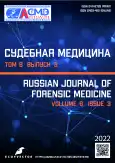Установление факта и особенностей переноса огнестрельным снарядом вещества преграды из многослойных и комбинированных материалов
- Авторы: Кузьмина В.А.1, Пинчук П.В.1,2, Леонов С.В.1,3, Сухарева М.А.3
-
Учреждения:
- 111 Главный государственный центр судебно-медицинских и криминалистических экспертиз
- Российский национальный исследовательский медицинский университет имени Н.И. Пирогова
- Московский государственный медико-стоматологический университет имени А.И. Евдокимова
- Выпуск: Том 8, № 3 (2022)
- Страницы: 29-35
- Раздел: Оригинальные исследования
- URL: https://journal-vniispk.ru/2411-8729/article/view/122458
- DOI: https://doi.org/10.17816/fm681
- ID: 122458
Цитировать
Полный текст
Аннотация
Обоснование. В настоящее время вопросы установления факта ранения человека огнестрельным снарядом через конкретный вид преграды или вследствие рикошета от неё, а также идентификации материала преграды практически не изучены.
Цель исследования ― установление факта и особенностей переноса огнестрельным снарядом материалов многослойных и комбинированных преград (триплекс, комбинированная преграда из керамогранита и пенобетона) при выстрелах патронами 5,45×39 из автомата Калашникова специального укороченного.
Материал и методы. Выстрелы производились через различные виды преград по биологическому имитатору тела человека с расстояния 5 м. Все эксперименты фиксировались посредством скоростной видеосъёмки с применением видеокамеры Sony RX0 с частотой 1000 кадров/сек. Пули и их фрагменты, извлечённые из пулеулавливателя или тканей биологической мишени, после соответствующей обработки исследовали посредством микроскопа Leica M125, сканирующего электронного микроскопа Hitachi FlexSem 1000 II и энергодисперсионного рентгеновского спектрометра Bruker Quantax 80.
Результаты. Световая микроскопия огнестрельных снарядов, преодолевших преграду, выявила наличие характерной деформации пуль при пробитии ими каждого вида исследованных преград. Сканирующая электронная микроскопия (SEM) и энергодисперсионный анализ (EDX) позволили выявить в каждом случае наличие наложений частиц преграды по всем поверхностям как деформированных пуль, так и фрагментов их оболочек и сердечников.
Заключение. Проведённое экспериментальное исследование доказало, что посредством сканирующей электронной микроскопии (SEM/EDX) возможно достоверно устанавливать факт огнестрельного ранения человека через преграду из многослойных и комбинированных материалов.
Полный текст
Открыть статью на сайте журналаОб авторах
Вера Александровна Кузьмина
111 Главный государственный центр судебно-медицинских и криминалистических экспертиз
Email: kuzminava@yandex.ru
ORCID iD: 0000-0003-0694-673X
SPIN-код: 1167-4112
Россия, Москва
Павел Васильевич Пинчук
111 Главный государственный центр судебно-медицинских и криминалистических экспертиз; Российский национальный исследовательский медицинский университет имени Н.И. Пирогова
Email: pinchuk1967@mail.ru
ORCID iD: 0000-0002-0223-2433
SPIN-код: 7357-3038
д.м.н., доцент
Россия, Москва; МоскваСергей Валерьевич Леонов
111 Главный государственный центр судебно-медицинских и криминалистических экспертиз; Московский государственный медико-стоматологический университет имени А.И. Евдокимова
Автор, ответственный за переписку.
Email: Sleonoff@inbox.ru
ORCID iD: 0000-0003-4228-8973
SPIN-код: 2326-2920
д.м.н., профессор
Россия, Москва; МоскваМарина Анатольевна Сухарева
Московский государственный медико-стоматологический университет имени А.И. Евдокимова
Email: suha@yandex.ru
ORCID iD: 0000-0003-3422-6043
SPIN-код: 4692-0197
к.м.н.
Россия, МоскваСписок литературы
- Калмыков К.Н. Судебно-медицинская характеристика поражения обыкновенными и специальными пулями образца 1943 г., предварительно преодолевшими преграду: Дис. … канд. мед. наук. Ленинград, 1961. 462 с.
- Исаков В.Д. К вопросу взаимодействия пули с преградой // Актуальные вопросы теории и практики судебной медицины: материалы научно-практической конференции, посвященной 40-летию снятия блокады Ленинграда и полному освобождению Ленинградской области от немецко-фашистских захватчиков. Ленинград, 1986.
- Гусенцов А.О. Судебно-медицинская диагностика входных пулевых огнестрельных повреждений, образовавшихся в результате рикошета: Автореф. дис. ... канд. мед. наук. Минск, 2013. 23 с.
- Гусенцов А.О., Кильдюшов Е.М., Туманов Э.В. Современное состояние судебно-медицинской экспертизы и экспериментальных исследований запреградной огнестрельной травмы // Судебно-медицинская экспертиза. 2019. Т. 62, № 2. С. 61–66. doi: 10.17116/sudmed20196202161
- Гусенцов А.О., Кильдюшов Е.М. Имитатор тела человека как входной параметр баллистического эксперимента // Судебно-медицинская экспертиза. 2020. Т. 63, № 5. С. 23–29. doi: 10.17116/sudmed20206305123
- Денисов А.В., Тюрин М.В., Сохранов М.В., и др. Особенности поражения живых целей в зоне рикошета пуль при стрельбе по твердым преградам // Вестник Российской военно-медицинской академии. 2014. № 1. С. 179–183.
- Mattijssen E., Pater K., Stoel R. Ricochet behavior on glass-critical ricochet angles, ricochet angles, and deflection angles // J Forensic Sci. 2016. Vol. 61, N 6. Р. 1456–1460. doi: 10.1111/1556-4029.13201
- Thornton J.I., Cashman P.J. The effect of tempered glass on bullet trajectory // J Forensic Sci. 1986. Vol. 31, N 2. Р. 743–746.
- Kerkhoff W., Alberink I., Mattijssen E. An empirical study on the relation between the critical angle for bullet ricochet and the properties of wood // J Forensic Sci. 2015. Vol. 60, N 3. Р. 605–610. doi: 10.1111/1556-4029.12738
- Vermeij E., Rijnders M., Pieper P., Hermsen R. Interaction of bullets with intermediate targets: material transfer and damage // Forensic Sci Int. 2012. Vol. 223, N 1-3. Р. 125–135. doi: 10.1016/j.forsciint.2012.08.016
Дополнительные файлы










